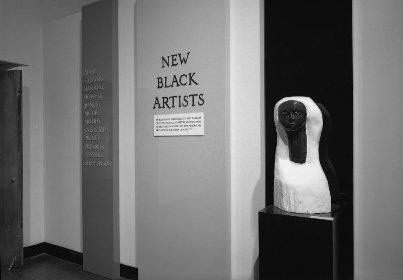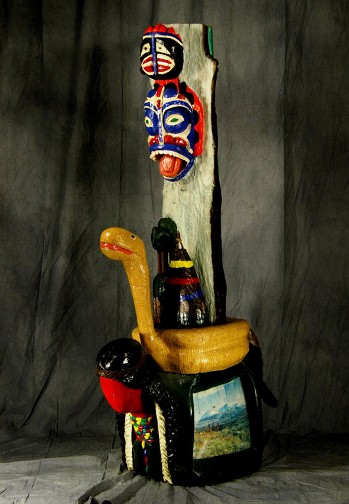


artwork | video | statement | bio | bibl. | press | resume

African-American Visual Artists – An Annotated Bibliography of Educational Resource Materials. Daniel Frye. The Scarecrow Press, Inc.: Lanham, MD, February 7, 2001
Almanac of African American Heritage: A Book of Lists Featuring People, Places, Times, And Events that Shaped Black Culture. Juanita J. Davis, Sharon E. Ferguson-Roberts, Rita G. Giles and Johnnie H. Miles. Prentice Hall: Upper Saddle River, NY, 2000.
Anonymous.”Harlem Unveiling.” New York Post: New York, NY, August 26, 1975.
Black Art – Ancestral Legacy: The African Impulse in African-American Art. Robert V. Rozelle, Alvia Wardlaw and Maureen A. McKenna, ed. Dallas Museum of Art: Dallas, TX, 1989.
Bullard, C. “African Roots Nourish Universal Images.” Richmond Times-Dispatch: Richmond, VA, October 15, 1993.
Canady, John. ” Sculpture is the Strength of New Black Artists’ Show.” The New York Times: New York, NY, October 8, 1971.
Chandler, Dana. “Anderson Pigatt: A Self-Taught Artist.” Bay State Banner. Boston, MA, November 22, 1973.
Dorsey, John. “Pigatt Retrospective.” The Baltimore Sun: Baltimore, MD, October 20, 1998.
King Hammond, Leslie. Masters, Mentors and Makers.Pavsner Press: Baltimore, MD, 1992.
King Hammond, Leslie. The Intuitive Eye. Harbor Exchange: Baltimore, MD, 1985.
Masters, Barbara. “Integrity of the Message and the Medium.” AURA of the Arts: Baltimore, MD, August 1977.
Pigatt, A. “A Tree Returns to Harlem.” New York Voice: New York, NY, Aug. 29, 1975.
Preston, Malcolm. “Distinctly Black.” Newsday: Long Island, NY, December 24, 1971.
Sharp, Christopher. “Arts and Pleasures, Stories in Wood.” Womens Wear Daily: New York, NY, August 31, 1976.
Smythe, Victor. Black New York Artists of the 20th Century: Selections from the Schomburg Collections. New York Public Library Press: New York, NY, 1998.
Speaking Spirits: Nov. 18-Dec. 2, 1973: Sculpture by Anderson J. Pigatt: Museum of National Center of Afro-American Artists. National Center of Afro-American Artists, 1973
Stevens, Elisabeth. “Intuitive Eye is Artists’ Vision.” The Baltimore Sun: Baltimore, MD, June 6, 1985.
St. James Guide to Black Artists: Schomburg Center for Research in Black Culture. Thomas Riggs. St James Press: An Imprint of Gale: Detroit, MI, 1997.
Taylor, Edward. New Black Artists.Clarke and Way, Inc., 1969.
Taylor, Robert. “Anderson J. Pigatt Sculpture Seen in Speaking Spirits.” Boston Globe: Boston, MA, November 22 ,1973.

artwork | video | statement | bio | bibl. | press | resume

Most of us have lost the real reason why we came into this world, and believe me there is a reason, only known to you – not your mother, father, sister, brother or anyone on this earth – only you before your entry. But if we do as we were intended to do – that is to move around this world – we will find our path again, making us happy for finding the truth. Don’t wait for the truth to come to you; most likely it is a lie.
The path, when found, we must walk until death. If a man takes a wife, and he is of path, truth, love and good health, old age will come to them a happy death. For sickness is a lack of work, and work should be doing the things that make life better for you, your family and friends. If there are kids, they must grow free with only the teaching of truth, so they can keep moving toward their path. And in a lot of cases the son’s path will be the same as the father’s, for the father’s truth will shine bright in the eyes of the son.
Age to me means wisdom: how to move, where to move, what to do, what not to do, and to keep moving toward your end. The end could very well mean another beginning in another life. I often think of my father on his deathbed and the last thing he said that was understood. He said, “What has a man gained if he’s gained the world and lost his soul?” I guess this is why I’m a woodworker, for you see, wood to me is always alive.
These dead trees that I write stories on may last 1,000 years for the world to see. And even though they might become outdated, they are a part of our time. I feel as though some day others may laugh at them to know that man was so dumb. Yet we all work toward that day when killing and hating another man’s color will be a thing of the past, when work will be a thing of enjoyment for all man; the time when there will be no rich man or poor man, black man or white – only man. For when God made man, there were lights, color and sound, happiness all around, and my dream is to bring it about again by returning light, color and sound to the consciousness of mankind. And I will work until hate be replaced with love and greed is replaced with giving.
Powerful is the man of truth and love, taking nothing and giving eternal life.

artwork | video | statement | bio | bibl. | press | resume
 Anderson Pigatt was born in Raeford, North Carolina, October 20, 1928. He received vocational training in general woodworking and carpentry at George Washington Carver High School. Pigatt served in the United States Army in 1950-55; studied cabinetmaking on the G.I. Bill after leaving the military; and apprenticed under James W. Leach, Baltimore, Maryland in refinishing and repairing period antique furniture.
Anderson Pigatt was born in Raeford, North Carolina, October 20, 1928. He received vocational training in general woodworking and carpentry at George Washington Carver High School. Pigatt served in the United States Army in 1950-55; studied cabinetmaking on the G.I. Bill after leaving the military; and apprenticed under James W. Leach, Baltimore, Maryland in refinishing and repairing period antique furniture.
Pigatt performed free-lance work in New York after 1963, working for firms such as Worldwide Antiques, Leonard’s Antique Gallery, Knapp and Seigal Antiques, et al. Restoration experience includes work on Chippendale, Jacobean, Sheraton, Queen Anne and other types of collections.
Anderson launched his sculpture career late in 1960’s. A self-taught sculptor, his work is represented in a number of private and institutional collections.
“Nigger Chained” a seminal work is in the permanent collection of the Schomberg Center for Research in Black Culture in New York. Other sculptures are in the Brooklyn Museum, Brooklyn, New York; Reginald F. Lewis Museum, Baltimore, MD; and the American Visionary Art Museum, Baltimore, MD.
Mr. Pigatt participated in exhibitions sponsored by the American Federation of Fine Arts, the Urban Center of Columbia University, the Harlem Council and Bell Telephone Company. From December, 1967-1976, his work was exhibited in such venues as the Empire State Building, Observation Tower, New York, NY; The Pam Am Building, New York, NY; the Brooklyn Museum, New York, NY; Columbia University, New York, NY; Elma Lewis School of Fine Art, Dorchester, MA; University of Florida, Gainesville, FL; Milliken University, Decatur, IL; Reading Public Museum and Art Gallery, Reading, PA; University of Wisconsin, Milwaukee, WI; and the Illinois State Museum, Springfield, IL.
Significant exhibitions include: “Black New Artists of the 20th Century: Selections from the Schomburg Center Collections”, 1970; traveling exhibitions “New Black Artists”, 1971 and “Black Art – Ancestral Legacy: The African Impulse in African-American Art”, 1989-91.
Anderson’s work was favorable reviewed and commented upon by such notables as John Canady of The New York Times on October 8, 1969, with a headline stating “Sculpture Is Strength of ‘New Black Artists’ Show” and Robert Taylor of the Boston Globe on November 22, 1973 with the headline “Anderson Pigatt’s sculpture seen in ‘Speaking Spirits’”. Other comments and accolades come from correspondence from Thomas W. Leavitt, Director of the Herbert f. Johnson Museum of Art at Cornell University, Joseph V. Noble, Vice Director for Administration at the Metropolitan Museum of Art in New York, and Dr. Robert Bishop, Director of Museum of American Folk Art in New York.
Mr. Pigatt was selected to participate in the exhibition and publication, Black Art Ancestral Legacy, sponsored by the Dallas Museum of Art, which showed at the High Museum in Atlanta, the Milwaukee Art Museum, and the Virginia Museum of Fine Art in Richmond. His work has been purchased by such notables as Singer Richie Havens, artists Andy Warhol and John Biggers.
